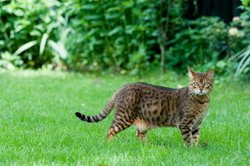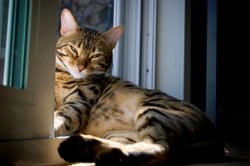|
The Bengal Catthe best of two worlds The Bengal cat breed is a hybrid breed. It is the result of a cross between a domestic cat with an Asian Leopard Cat, a small wild cat. This kitty certainly embodies the best of both worlds. The Bengal house cat inherited its exotic, leopard-like markings and sleek, muscular body type from its wild ancestors, and its gentle disposition and mild manner from its domestic forefathers (provided it is 4 times removed from the original hybrid). The Bengal house cat is a great representative of both worlds, so if you want to enjoy the wild and the domestic at the same time, a Bengal is just for you. Here's some Bengal cat information: The Bengal is a relatively new cat breed. The first reports of crosses between Asian Leopard Cats (ALCs) and domestic cats date back to the 1930s. However, Jean Sudgen, later Jean Mills, has been credited with developing the Bengal breed during the 60s and 70s. Interestingly, several domestic cat breeds have been used for Bengal breeding, including the Abyssinian, British Shorthair, Bombay, Burmese, and Egyptian Mau. In 1977, Bengal cats were first registered with the American Cat Fanciers Association (AFCA) as an experimental breed. In 1983, The International Cat Association (TICA) introduced the Bengal as a new cat breed. Both these organizations along with the Governing Council of the Cat Fancy (GCCF) currently accept the Bengal for registration. However, Bengals of early generations (F1, F2, F3) are not considered to be domestic cats, and are not allowed to be registered or to be shown. These early generation Bengals still retain wild characteristics and are not considered good pets. Currently, the Cat Fanciers Association (CFA) does not accept the Bengal (of any generation) for registration or shows. Even though these spotted cats are still rare, they have grown in popularity ever since they were first introduced to the public. Name originWhen we hear the name Bengal, images of the fierce Bengal tigers come to mind. However, the Bengal gets its name from the scientific name of the Asian Leopard Cat, which is Prionailurus bengalensis. And indeed, the Bengal looks more like a leopard than a tiger. Physical traits and behavior
The Bengal’s coat is dense but soft to the touch, and it’s either marbled or spotted. The markings are well defined and include spots, rosettes (bi-color markings) and stripes. The Bengal can live an average of 15 years. Color patternsBengals come in many color and pattern variations. The base color alone can go from silver-gray to brown. And then you add spots, stripes and swirls and you get a beautiful, exotic little beast. These are some of the colors/patterns Bengal house cats come in:
In my opinion, marble Bengal cats are some of the most striking cats. The swirls and stripes give these felines a very distinctive look. Seal Lynx Points, Seal Minks, and Seal Sepias, which are also known as snow Bengal cats, are also unique-looking cats. Learn more about Bengal colors and patterns. Bengal behaviorThese "wild" kitties are extremely intelligent, fun-loving and of good disposition. Again, cats from the first through the third generation are not considered good pets, so keep that in mind. Domestic Bengal cats are also social and affectionate, making them great pets. So if you want to enjoy the beauty of the wild cats, but want a "tamed" kitty, then the Bengal will be perfect for you. Bengal-inspired giftsIf you know a Bengal-cat lover, consider these gift ideas: -- Bengal-themed magnets and coasters -- Calendars -- Plush toys And for more ideas, visit our Bengal gifts page here. If you just adopted a Bengal cat and are searching for a name for him or her, check the Bengal-cat name page, here. Fun Bengal-cat videosBengals are funny, playful, and talkative as the following videos show: Bengal kitten playing with water Bengal cats are very agile, too
|
 Mia was lovely, courageous, and one of the wisest cats I've ever met. This site is dedicated to her memory.
Mia was lovely, courageous, and one of the wisest cats I've ever met. This site is dedicated to her memory.
Max
 Max is our very own magical cat. He loves big mouse toys and is an avid bird watcher.
Max is our very own magical cat. He loves big mouse toys and is an avid bird watcher.






 The Bengal is a medium to large cat. The adult females weigh from 7-12 pounds on average. Bengal males weigh from 11 to 19 pounds. Sleek and strong, they indeed look like wild cats.
The Bengal is a medium to large cat. The adult females weigh from 7-12 pounds on average. Bengal males weigh from 11 to 19 pounds. Sleek and strong, they indeed look like wild cats. 